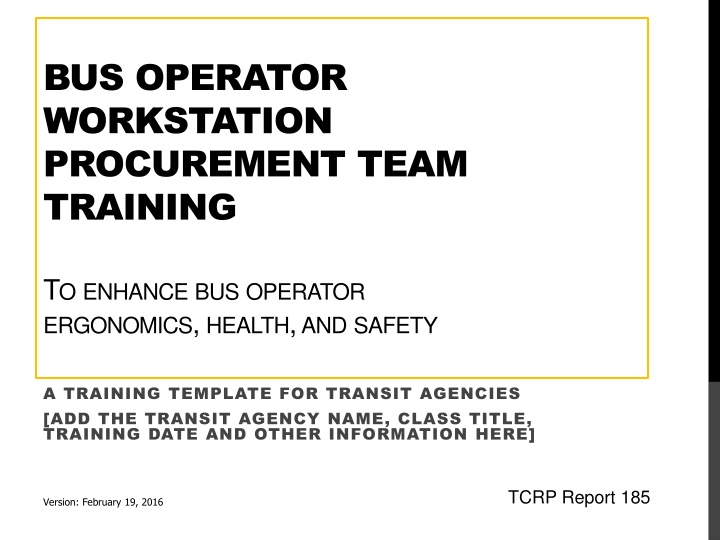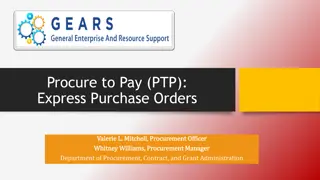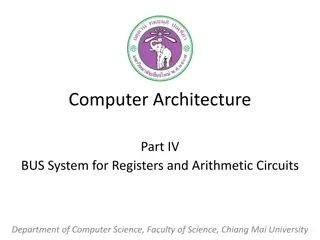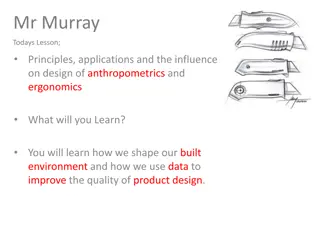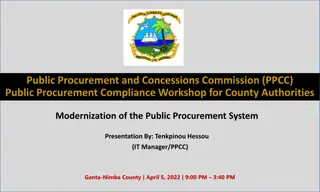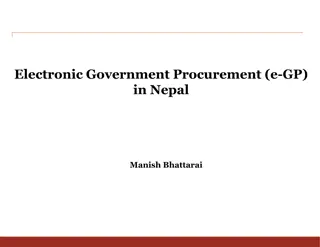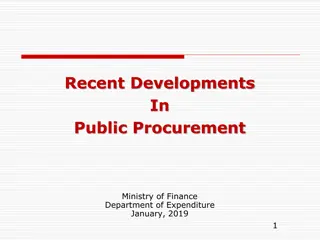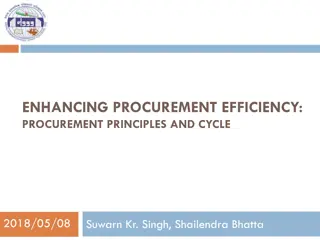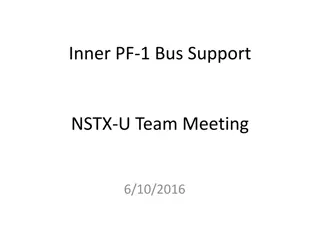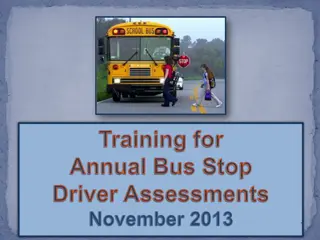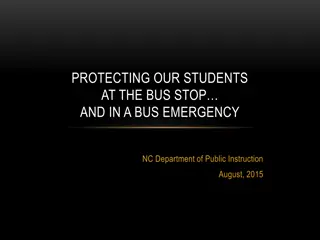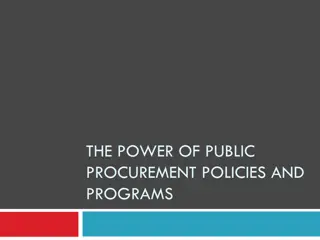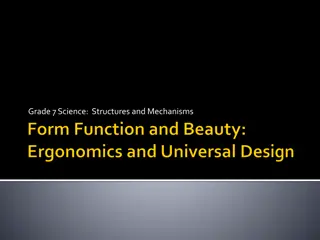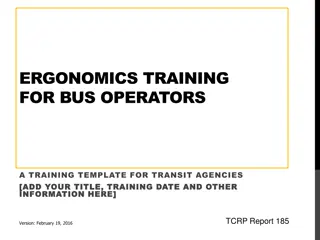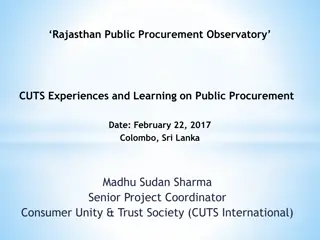Bus Operator Workstation Procurement Team Training for Enhanced Ergonomics, Health, and Safety
This training template aims to assist transit agencies in preparing and supporting their procurement teams to ensure buses purchased promote best practices in ergonomics, health, and safety. The template covers modules on procurement processes and updates, providing valuable guidance and resources for enhancing bus operator workstations.
Download Presentation

Please find below an Image/Link to download the presentation.
The content on the website is provided AS IS for your information and personal use only. It may not be sold, licensed, or shared on other websites without obtaining consent from the author.If you encounter any issues during the download, it is possible that the publisher has removed the file from their server.
You are allowed to download the files provided on this website for personal or commercial use, subject to the condition that they are used lawfully. All files are the property of their respective owners.
The content on the website is provided AS IS for your information and personal use only. It may not be sold, licensed, or shared on other websites without obtaining consent from the author.
E N D
Presentation Transcript
BUS OPERATOR WORKSTATION PROCUREMENT TEAM TRAINING TO ENHANCE BUS OPERATOR ERGONOMICS, HEALTH, AND SAFETY A TRAINING TEMPLATE FOR TRANSIT AGENCIES [ADD THE TRANSIT AGENCY NAME, CLASS TITLE, TRAINING DATE AND OTHER INFORMATION HERE] TCRP Report 185 Version: February 19, 2016
EXPLANATION This training template is designed to help transit agencies prepare and support their procurement teams in ensuring that the buses they purchase promote best practice ergonomics, health and safety. The template is organized in module outlines covering the knowledge and skills areas recommended by transit agencies, unions and industry experts, and the objectives for each module. The specific content required should be adapted and developed by the transit agency. Reference materials and existing trainings are suggested. This template is designed to be filled in with information, images and content that are specific to the transit agency and the group being trained. 2
TRAINING AREA 1: PROCUREMENT Training about how procurement works at the transit agency should be provided to all new procurement team members and to other stakeholders as desired so they can participate as needed. Training should be updated for all procurement team members at the initiation of procurement cycle or as changes occur. Modules: 1. Procurement as practiced at the agency 2. Procurement update 3
MODULE 1: PROCUREMENT PROCESS Review steps of real life bus procurement acquisition planning Understand stakeholder and team roles Purpose Purpose Current procurement protocol Practical examples of targeted design areas for bus operator health and safety, and what is involved with those specifications Content Content Presentation by group facilitator or procurement staff Recommended Bus Procurement Team Process Guidance Tool Materials Materials 4
MODULE 2: PROCUREMENT UPDATE Establish common understanding of process Review upcoming procurement calendar Identify process changes Define team roles Purpose Purpose Review of agency procurement, highlighting any changes Calendar: information collection, analysis and planning, specifications, RFP, review, award, factory visit, pilot, roll out, warranty period, evaluation Team chart and roles Feedback on previous process, gaps, skills needed Content Content Previous specification document Team chart and responsibilities Calendar Materials Materials 5
TRAINING AREA 2: TECHNICAL SKILLS AND KNOWLEDGE All procurement participants should understand the basics of the bus operator workstation design related to ergonomics, health and safety. A summary explanation may be adequate for those not making material decisions. An active role in identifying problems, suggesting and assessing changes, and testing delivered buses calls for more detailed training. These modules can be prepared by the transit agency staff who have experience in the area. The Ergonomics for bus operators template developed with this project can be adapted for module 4. Modules: 3. How the workstation affects operator health and safety 4. Ergonomics 5. Occupational health and safety 6. Driving 7. Maintenance 6
MODULE 3: HOW THE WORKSTATION AFFECTS HEALTH AND SAFETY Define the demands of driving that can affect bus operator health and safety seating controls visibility signage farebox wheelchair passenger interaction Purpose Purpose Content Content Presentation by staff that experience in bus operations Images, prototypes or access to current workstation and past elements that caused problems Bus Workstation Design Features Guidelines APTA Standard Bus Procurement appendices as updated Materials Materials 7
MODULE 4: ERGONOMICS Define workplace ergonomics demands, including biomechanics and human factors Identify how these affect bus operators Apply knowledge to practical examples and develop solutions joint posture force demands reach vibration anthropometrics seated work stress Presentation by safety staff NTI Musculoskeletal Disorder Awareness and Prevention (Direct Delivery) NTI Musculoskeletal Disorder Awareness and Prevention (Train the Trainer) OSHA #2255 - Principles of Ergonomics Purpose Purpose Content Content Materials Materials 8
MODULE 5: OCCUPATIONAL HEALTH AND SAFETY Describe the common health and safety hazards for bus operators Explain fundamentals of OSH and industrial hygiene Review Agency s safety structure, reporting system Define areas of bus cab design that affect safety and health Purpose Purpose Vehicle safety as it affects the operator Hierarchy of controls Hazards and controls: Slips and falls Environment: heat, cold, air quality, light Health and wellness, including seated work, stress Assaults in the bus work environment Content Content Workshop prepared by safety department or joint safety committee Transit health and safety handouts OSHA 10-hour or 30-hour General Industry Outreach Training Course (adapted for transit) OSHA #521 - OSHA Guide to Industrial Hygiene Materials Materials 9
MODULE 6: DEMANDS OF DRIVING Explain and demonstrate driving demands Identify cab configuration issues in current fleet Purpose Purpose Physical challenges Work schedule challenges Cognitive load Targets for procurement Content Content Bus operators interactive workshop or presentation on driving demands Operations perspective on procurement for safety and health targets and limitations Bus assessment checklist A Transit Workplace Health Protection and Promotion Practitioner s Guide from TCRP Report 169 Materials Materials 10
MODULE 7: DEMANDS OF MAINTENANCE WORK Explain and demonstrate maintenance ergonomics demands Identify cab configuration issues in current fleet Purpose Purpose Physical demands of work Importance of equipment selection and placement on safety and health, including maintainers Content Content Maintainers presentation on cab configuration Maintenance Department perspective on procurement for safety and health targets and limitations Materials Materials 11
TRAINING AREA 3: ADVANCED TECHNICAL SKILLS AND KNOWLEDGE Some team members or others in the transit agency may already have advanced training or technical skills. The transit agencies can call on these people to provide explanations or even more formal training to the rest of the team. Advanced training is especially important in areas such as bus design and testing when the team, and sometimes bus operators or maintainers, are involved in bus evaluation. Modules: 8. Product and vehicle design 9. CAD modeling, blueprints and specifications, 10. Product testing 12
MODULE 8: PRODUCT AND VEHICLE DESIGN Define background for bus design, selection and build Allow procurement team to make practical and effective proposals for improvements Provide tools for developing effective RFPs Purpose Purpose Steps in design: concept, CAD, mock up, functional prototype, pilot, production Stakeholder roles in participatory ergonomics Bus manufacturer design and build processes Content Content Presentation by engineers, maintenance or procurement Summary from manufacturer about their design and build processes Bus Workstation Design Features Guidelines and 3-D PDF Universal Model Materials Materials 13
MODULE 9: CAD AND SPECIFICATIONS Communicate basic skills for interpreting and commenting on images and descriptions of equipment Provide experience with tools used in design and procurement Practice reading blueprints and design specs Purpose Purpose Blue print reading Specifications models Using the Bus Operator Workstation Engineering CAD Model Using the universal 3-D PDF Model Content Content Presentation by maintenance or engineering staff Examples from last procurement Bus Operator Workstation CAD Model and the 3-D PDF Universal Model Materials Materials 14
MODULE 10: PRODUCT TESTING Support the organization in evaluating new equipment and cab configuration changes Establish a common language for discussing product and vehicle testing Design a testing protocol format to adapt as needed during procurement Purpose Purpose Phases of equipment and vehicle testing for occupational health and safety Planning an effective testing protocol Prototypes and mockups Testing to failure Content Content Presentation by design expert, engineering or maintenance Use existing or develop: - Bus cab specification checklist (developed with input from engineer, maintenance, bus operators) - Checklists for specific equipment - Evaluation forms Materials Materials 15
